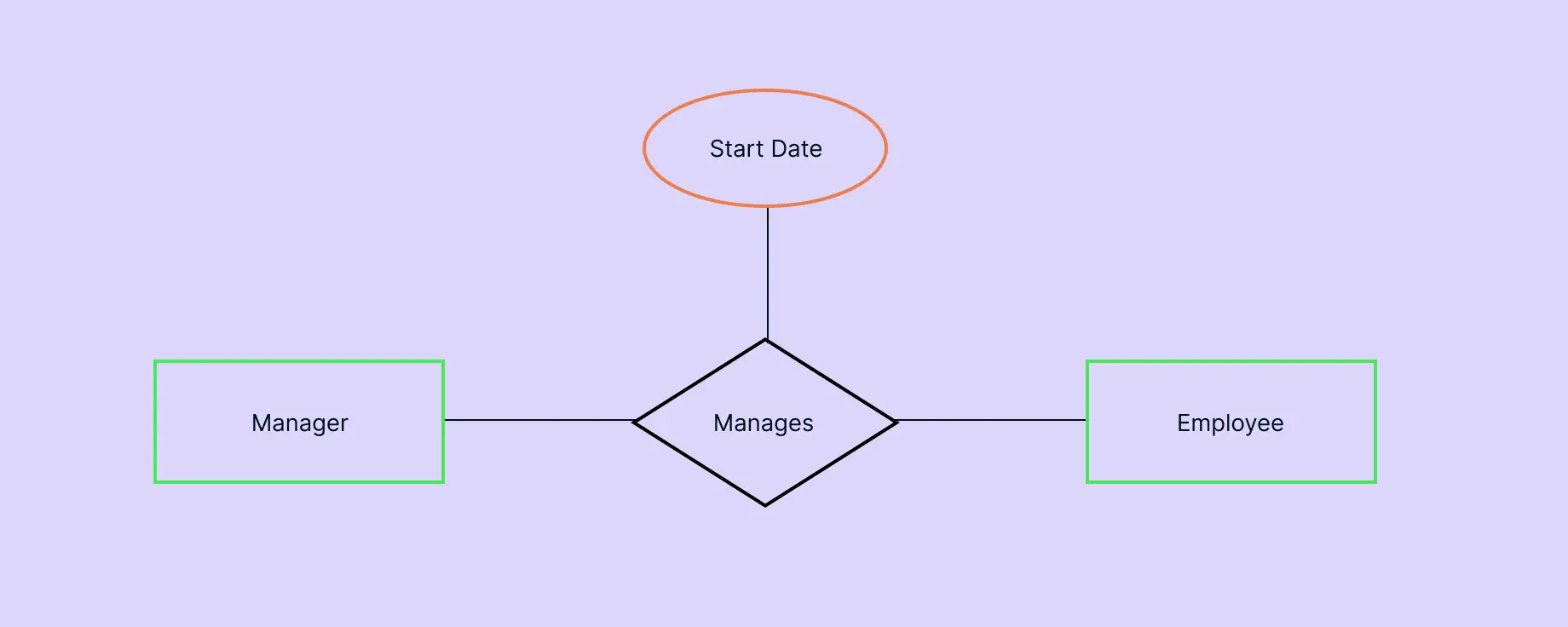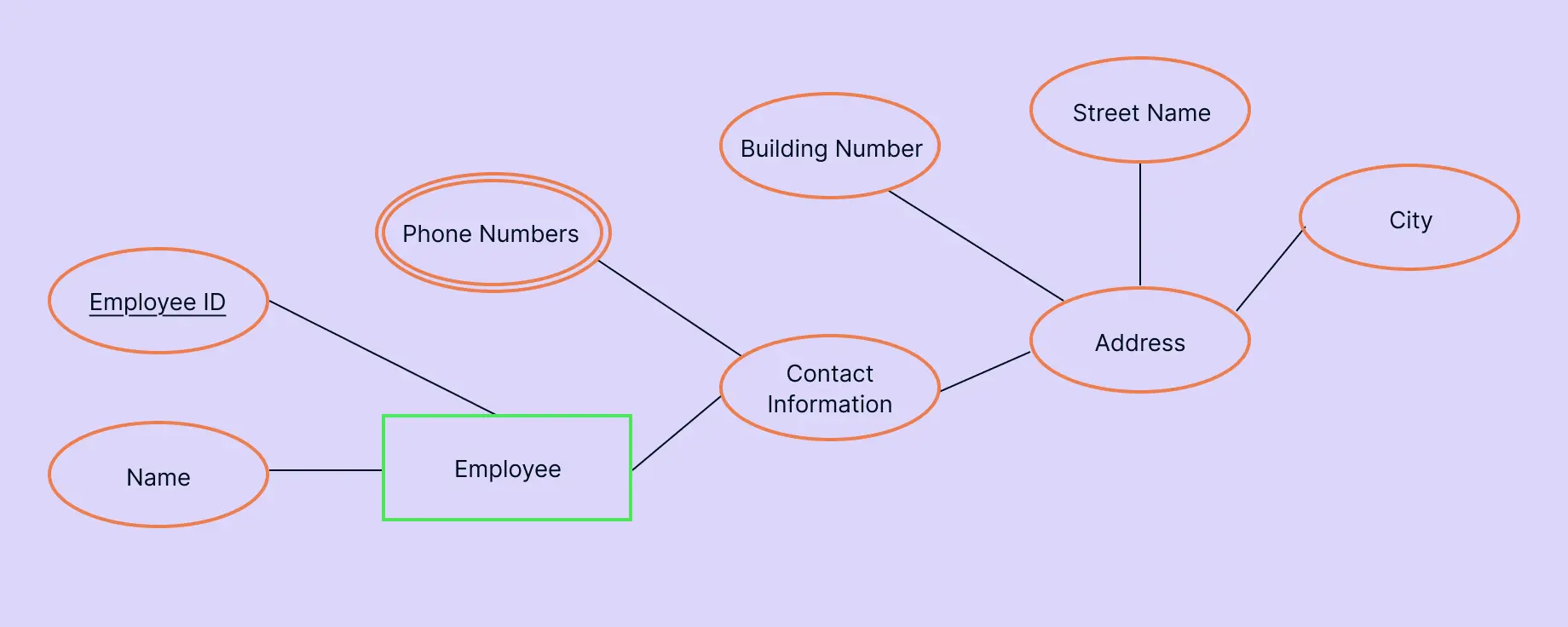Attributes in ERD play a crucial role in defining and distinguishing entities within a database. From simple attributes that store atomic values to composite attributes that break down into smaller components, these elements help structure data meaningfully. Understanding attributes is essential for maintaining data integrity, optimizing queries, and ensuring effective relationships between entities. This guide explores the different types of attributes in ERD, their importance, and best practices for utilizing them in database modeling.
What are Attributes in ERD
In an Entity Relationship Diagram (ERD), an entity is the real-world concept or object that is represented as a rectangle or table in the database. Attributes define the characteristics or properties of an entity. They provide details about the entity and help distinguish one instance of an entity from another. There could be multiple attributes to an entity and each attribute holds its data as a column inside a table.
The example below shows an entity ‘User’ with and without its attributes (username, age and email).

This is what is called a ‘logical ERD’ which is a detailed diagram and yet does not contain all the information needed for database implementation. You can learn about other diagram types used in conceptual and physical data modeling in types of entity relationship diagrams.
Relationships in ER Diagrams
Relationships are what shows how entities interact with each other. These appear visually as diamonds between entities in conceptual ERDs with the relationship name written inside. In more advanced models, connecting lines with various notation styles such as crow’s foot are used to describe the kind of relationship. There could be many types of relationships such as one-to-one, one-to-many, or many-to-many depending on the use case.
Types of Attributes in ERD
In this section, you will learn what each type of attribute is, and which attribute symbols to use when drawing it in an ERD.
To learn more about entities, relationships and the symbols that represent them, check ER diagram symbols.
1. Simple Attributes
Simple Attributes cannot be divided further. The values they store are called ‘atomic values’ since these values are the smallest, indivisible units of data that can be stored in a table. An employee ID is an example of a simple attribute since it is usually a single numeric or alphanumeric value which cannot be broken into a simpler value. Simple attributes are represented by an oval in ERD.
2. Composite Attributes
A composite attribute in ER diagram design can be divided further into simple attributes. An employee name for example, is made of the first name, middle name and surname. An address is also a composite attribute, made up of building number, street name, city and so on. A composite attribute is shown as an oval that is connected to its constituent simple attributes.
3. Single-valued Attributes
These can only hold a single value at a time. For example, the date of birth, age or gender can be only a single value. These are usually shown by a single outline oval.
4. Multi-valued Attributes
As the name implies, multi-valued variables can contain many values at a time. This is like an employee having multiple phone numbers, email addresses, or qualifications. A double outlined oval is used to show this is in an ER diagram.
5. Stored Attributes
Stored attributes have data stored whose values do not change for a period of time. Date of birth is an example of a stored attribute. It can also be used to derive another attribute such as age. These are also called ‘base attributes’. A single outline oval is used for stored attributes.
6. Derived Attributes
The value of a derived attribute is derived from a stored attribute and can change over time. The age of an employee changes and is derived from their date of birth and the current date. The derivation can be based on simple mathematics or a complex algorithm. A dotted outline or dashed line oval is used to represent a derived attribute in ER diagram design.
There are many reasons for using deriving attributes instead of stored attributes. Derived attributes are calculated when needed, and not stored directly, saving space in the database. They also reduce the chance of human error during manual inputting or updating of data. Finally, derived attributes improve performance in situations involving complex queries.
7. Key Attributes
A primary key attribute is used in databases to uniquely identify an entity within an entity set. The employee ID is an example of such an attribute. A primary key attribute cannot be null and is shown by underlining the attribute name within the oval. To find out more about keys, check primary key in ERD.
A foreign key is one that helps in referencing by establishing a link between an entity carrying the primary key and another entity it is related to.
You can see all the different types of attributes used in the single ER diagram below. Some attributes may fall into multiple categories of attributes. Date of birth for example is a stored attribute that can also be categorized as a single-valued attribute.

Other Types of Attributes Used in ERD
Null Attributes
This type of attribute can have a null value if the entity does not have a value for it.
Descriptive Attributes
Sometimes, a relationship requires more contextual information. This can be provided by a descriptive attribute.

Complex Attributes
A complex attribute is made through nesting of multi-valued and composite attributes.

Why Attributes in ERD are Important
Without attributes, an ERD would lack the necessary details to create a functional database structure. Here are some reasons why attributes are essential in database design.
1. Uniquely Identifies Entities
Attributes like Primary Keys (e.g., Student ID, Employee Number) help distinguish one entity from another.
2. Provides Detailed Information
They store meaningful data about an entity, such as a person’s Name, Age, and Address.
3. Supports Data Integrity
Attributes ensure consistency by defining data types and constraints, preventing errors in the database.
4. Enables Relationships
Attributes help establish connections between entities, making it easier to model associations like ‘Student Enrolled in Course’.
5. Facilitates Queries & Analysis
Well-defined attributes allow efficient data retrieval, making searches and reports more effective.
Best Practices for Using Attributes
Here are some best practices for using attributes based on the types of attributes we have covered so far.
Use Clear Naming Conventions
Choose meaningful and consistent names for attributes to improve readability and understanding.
Define Attribute Domains
Specify the type and range of values an attribute can hold to maintain data integrity.
Avoid Redundant Attributes
Ensure attributes are necessary and do not duplicate information already stored in other entities.
Choose the Right Attribute Type
Use simple, composite, single-valued, multi-valued, stored, derived and key attributes appropriately based on the data requirements. If you have made it this far into this guide, you should have no trouble using the right attribute type.
Ensure Proper Key Selection
Identify primary keys and foreign keys correctly to establish relationships and maintain uniqueness.
Use Consistent Formatting
Represent attributes clearly in the ERD using ovals and underline key attributes for easy identification.
Creately ERD Templates with Attributes
Creately has hundreds of ERD templates you can use to quickly get started with your database designs. Here are some diagram examples that contain attributes.
Helpful Resources for Drawing ERDs
Learn a brief history of ER diagrams, the basic concepts and the different data models in use.
A must-read guide on ER diagram symbols and the notation styles used by professionals.
Browse our vast collection of ER diagram templates.
Use our free tool to start making your own ER diagrams.
Conclusion
If you’re a budding database engineer, learning the different types of attributes in ERD is a first step to structuring information efficiently. Choosing the right attributes, and following best practices can help you design a well-optimized database that supports accurate data retrieval and seamless interaction between entities when fully implemented.
Understanding attributes is key to developing scalable and effective database systems, making them an essential component in data modeling. If you’ve mastered the basics and are ready to ramp up your designs, try Creately, the visual diagramming solution that covers all your ERD needs!
FAQs about Attributes in ERD
What are attributes in a database?
Can an attribute be both a primary key and a foreign key?
What is a weak entity and how does it affect attributes?
Can attributes have relationships with other attributes?
Resources:
Li, F., Yang, J., Jin, C. and Guo, C. (2017). A new effect-based roughness measure for attribute reduction in information system. A new effect-based roughness measure for attribute reduction in information system, 378, pp.348–362. doi:https://doi.org/10.1016/j.ins.2016.08.056.
Silviu Cucerzan (2014). Name entities made obvious: the participation in the ERD 2014 evaluation. doi:https://doi.org/10.1145/2633211.2634360.
Song, I.-Y., Evans, M. and Park, U. (1995). A Comparative Analysis of Entity-Relationship Diagrams 1. Journal of Computer and Software Engineering, [online] 3(4), pp.427–459. Available at: https://www.cin.ufpe.br/~in1008/aulas/A%20Comparative%20Analysis%20of%20Entity-Relationship%20Diagrams.pdf.





